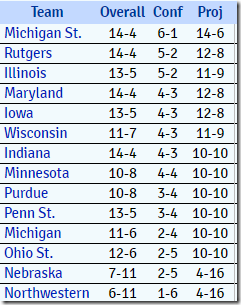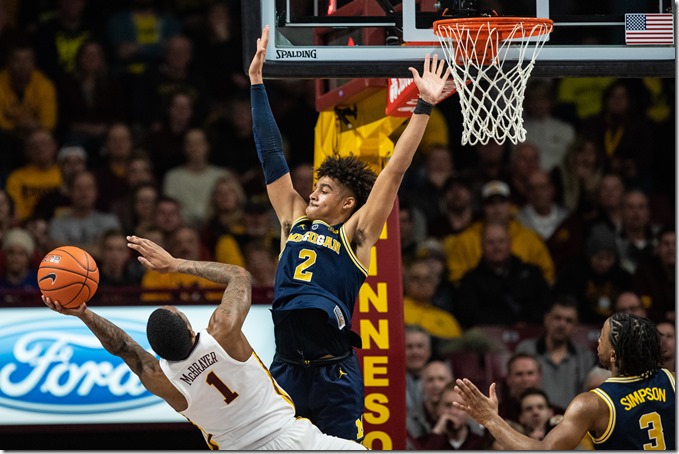robbie hummel

12/7/2021 – Michigan 102, Nebraska 67 – 6-3, 1-0 Big Ten
You don't want to take too much away from a game against Nebraska, because there are two kinds of games against Nebraska: one in which they hit a bunch of garbage and you have a mildly competitive game, and 35-point blowouts. After Keisei Tominaga hit two tough threes—one a relocation, the other a stepback over a Brooks contest—to give the brief semblance of the former, this one quickly settled into the blowout.
Nebraska's always been a team with huge roster turnover and this year is no different, so you have things like Michigan casually walking the ball upcourt and still getting what's more or less an open transition three for Caleb Houstan:
Jason Benetti is depressed on behalf of all basketball coaches everywhere who had to witness this. At some point even the partisan observer is asking Nebraska to show some sort of organization so that maybe this can be a better measuring stick
But! Nebraska has been reasonably competitive this year and this performance was far better than others against similar (or worse) levels of competition. At this point anything that suggests Michigan is working some things out is more than welcome. Bullets ahoy:
BULLETS
Shot quality: a thing. It's conventional wisdom in the land of the tempo-free stats that three point percentage against is largely random. This game set out to disprove that, with Michigan getting uncontested looks more or less whenever they wanted them and Nebraska throwing up piles of crap—step-backs, 30-footers, transition attempts on which the shooter never comes to a standstill, blindfolded HORSE shots. If you were to re-run this game over and over again there might be a few iterations where the teams came out with similar numbers from behind the arc, but the heart of Michigan's distribution would probably be 40% while Nebraska's was 20%.
The conventional wisdom is likely because most games against similarly matched teams have a similar quality of look from a similar quality of shooter. Over time things tend to even out. This does not mean that there are not individual shots that are good or bad. Usually the quality gap is much, much smaller.
[After THE JUMP: TEBJJ]

1/17/2020 – Michigan 83, Iowa 90 – 11-6, 2-4 Big Ten
I have seen the bracketology. I have seen the projections. I have seen Reservoir Dogs. But I am here to say that twelve Big Ten teams will not be in the tournament. There will be more than two teams with records worse than .500 in league play. Improbably, I do have to say that. Look at this thing!
This isn't going to happen. The most likely scenario is that a couple of teams sort themselves out naturally; the second is that when push comes to shove the committee passes on a team with an 8-12 conference record to select some other bubble team with a virtually identical resume.
Someone in this conference is going to be last year's Indiana team, which beat Marquette and Louisville, got off to a 12-2 start, and then lost 12 of 13 games. Someone is in the midst of a scene where a dude walks into the lobby of a building with a bunch of nonconference bling and gets riddled with bullets in slow-motion.
It's probably not Michigan, which has a note from the doctor about its performance to date. Torvik's measure of elite schedule strength has Michigan behind only Kansas and well ahead of the rest of the country:
Added Elite SOS (percentage of games an elite team would expect to lose against given schedule) to team charts page. pic.twitter.com/xOKYdhUOV4
— Bart Trvik (@totally_t_bomb) January 19, 2020
An elite team would expect to lose six games with Michigan's schedule. Michigan has lost six games, half of those without its top scorer.
…But it could be Michigan. Probably not. But maybe. Losing the last two games has been painful because both were within reach. Michigan had second-half leads with under ten minutes to go in both. There's no shame in losing either, but when everything's a coin flip and the first few go against you some nerves start popping up.
The schedule's about to ease up a bit, which means that they're getting teams in the back half of the top 50 at home instead of the front half on the road. Nothing is a lock. Even the horrible teams are projected to pick up five more wins between them, each of which will be a cruel bullet indeed.
It's probably not Michigan. It could well be Ohio State, which is in free-fall, having lost five of six with the only win at home against Nebraska. It could be Minnesota, or Illinois, or Indiana—my money is on Indiana again. But it could be Michigan. Collar-pulling time.
[After THE JUMP: there is an officiating section]

2/21/2019 – Michigan 69, Minnesota 60 – 24-3, 13-3 Big Ten
If you could go back in time six months and give your past self a stupefying Michigan sports update, your #2 option would be "Michigan basketball is 24-3 and it's tough to decide whether Zavier Simpson or Jon Teske is our best player." We will not discuss #1.
The needle swung to Simpson after the Maryland game, when he had 12 points on seven shot equivalents, 8 assists, one turnover, and more or less shut off Anthony Cowan for a half. The pendulum swung back to Teske in this one: 17 points on 11 shot equivalents, two assists, five blocks. Even more stunning: 36 minutes.
Teske sometimes seems to take his foot off the gas a little bit in the post, whether that's marshalling his strength or trying to avoid foul trouble. But every game he does enough to hold whoever he's directly checking to meh numbers (Oturu had 18 points on 18 shot equivalents and a TO) while hedging everyone's ball-screen game into oblivion and coming in for help defense on the regular. There's a point in every game where Teske gets a closeup and my reaction is "my goodness that person is red," but dude just keeps going. Michigan would be dead in the water if he could only play 20 MPG like a lot of guys his size. He is Camp Sanderson's magnum opus.
Anyway:
That's Minnesota for you. It took Minnesota 28 minutes to make a basket outside of the paint. The Gophers had 18 points at halftime. Eight of these were on initial attempts. They were able to claw ten more out off of putbacks, which is a little frustrating since the Gophers haven't been that good at OREBs in league play and Michigan has maintained their DREBs much better than they usually do.
The margins are are pretty thin. Given the number of rebounding opportunities Minnesota had (47!) Michigan would expect to give up 12.5 OREBs; instead they gave up 15. This places it into a category where we're mildly frustrated about bounces.
In part because of the above this was a game in which the Gopher had a huge shot volume edge. They had 7 more OREBs than TOs. Michigan was –4. To hold a team with a shot volume index over one to 0.9 PPP means you are crushing them everywhere except the offensive boards.
wall up! [Ludeman]
Verticality. Part of the trouble the Gophers had was their tendency to run pell-mell at the rim and try to chunk something up. That style is why they lead the league in free throw rate. In this one it mostly led to very tough attempts after taking contact. This was most notable on two missed dunks where Teske walled up vertically and contested.
Doink pic.twitter.com/Y7uILIYeWu
— Noah Neidlinger (@candor_for_sale) February 22, 2019
Amir Coffey's bounced spectacularly outside the three point line; Teske was called for a foul on a near-identical Jordan Murphy play. (Murphy missed both FTs, ball don't lie.)
With the exception of that foul, though, the officials allowed Michigan to contest.
When verticality is called correctly it's such an excellent rule change, rewarding defenses for being in good position without flopping and placing a priority on open shots for the offense all the way to the rim. The best example in this game was not either Teske contest but Amir Coffey getting downhill only for Simpson to show. Simpson was outside the restricted arc (I think) but instead of trying to flop he went up to contest; Coffey bumped him, missed the ensuing tough shot, and Michigan rebounded. That is infinitely superior to a guy standing on the ground and falling over in the hopes of stopping the game with a foul call.
[After THE JUMP: attacking switches, finally]


42